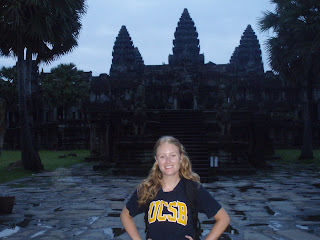























As an American you cannot visit Vietnam without contemplating the 25-year war we fought there. We call it the Vietnam War and the Vietnamese appropriately refer to the struggle as the American War. Vietnam is an interesting place to visit not only because of its heart wrenching history plagued with war and destruction; but for me the history certainly added to the power of its beauty and the respect you felt for the Vietnamese people. This country paid a large price for its sovereignty and you cannot escape the evidence of war here. Vietnam was awe-inspiring for me as an American. I believe that the blatant tenacity of the Vietnamese people and the magnificence of the land is provoking and makes one very introspective. No matter what your politics may be, traveling through this beautiful country is a humbling experience. It brings you to terms with your own values and forces you to think about American Ideals and American politics and about who pays for our blunders. It also made me think about the American soldiers and the price they payed for this war. It seemed that every time I let my mind wander while I looked out of the bus window at the landscape, the same thought would cross my mind, "what the hell were we doing fighting in Vietnam?"
The scenery of Vietnam is absolutely mesmerizing: the glistening rice patties, the gorgeous green water and karst peaks of Ha long Bay, the lush plains of the Mekong Delta and the bustling hyperactivity of Hanoi and Saigon come together to create an image of extreme splendor. These places and others make Vietnam one of the most distinctive and glittering gems of South-East Asia.
But beyond the scenery, I felt the history and the strength of the Vietnamese made everything you saw much more sacred. These fields and cities were for me symbols of how much people are willing to sacrifice for their land. Everywhere you look there were reminders of what this scenery meant to the Vietnamese. The more I learned about their history and the numerous countries that attempted to dominate their lands, and the bloodshed that was spilled by men, women and children fighting to keep their country. The more honored I felt being here and putting the history in context. I felt that I understood their struggle a little bit better and it gave me a more accurate depiction of the place and the Vietnamese people to juxtapose with the image of Vietnam found in the American history books. I felt I could empathize with these people and their suffering and the sense of pride felt in their defeat of imperialists such as the French and Americans. I also learned to face my American misconceptions that we are always fighting on the side of democracy and justice. Sometimes we are just plain wrong. But for me visiting Vietnam and meant coming to terms with the guilt I felt about being an American citizen and facing the music about our governments actions in Vietnam. When visiting the Remnants of War Museum in Saigon, looking at the old U.S. tanks and Bombers they had on display outside the museum gave you a real understanding of what the Vietnam were up against and the strength of the U.S. military. The graphic pictures of the brutality of the war and the effect agent orange had and is still having on both Vietnamese and U.S. soldiers was enough to make you want to gag and cry at the same time. It made my heart hurt with sympathy for American soldiers and Vietnamese citizens alike.
After having to come face to face with the history of the Vietnam War and the destruction and death I realized that our single enemy, the most evil thing on this planet is war. That is true for Americans, Vietnamese and everyone else a like. Those of us who have not had to fight in a war, we truly are the fortunate ones.


















































